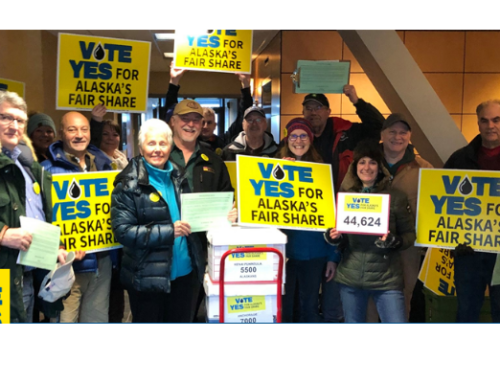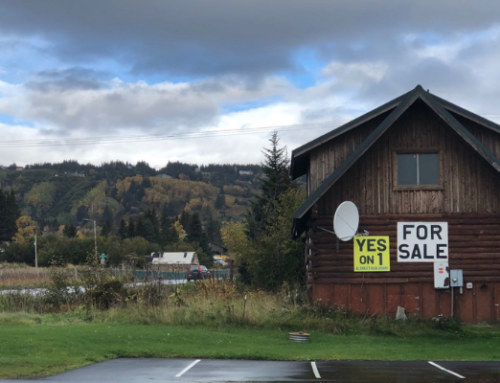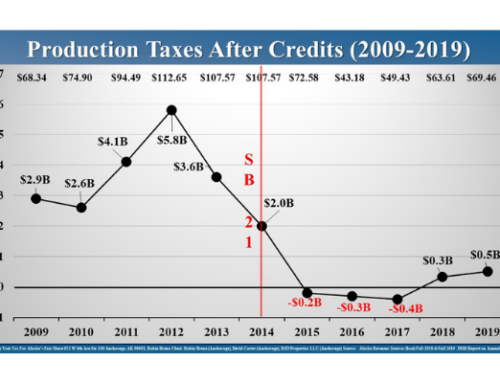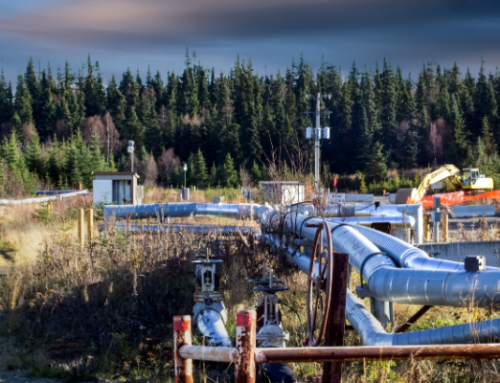by Robin Brena
I recently suggested Alaskans should recover a fair share of our petroleum wealth. There have been several well-taken responses to my suggestion. The purpose for this article is to reply to those responses so we may continue an important conversation for Alaskans’ futures.
WHAT IS OUR FAIR SHARE?
Alaskans should receive one-third of the gross petroleum revenues being generated by the sale of our crude oil as our fair share. This one-third share has been the rough standard for revenue sharing since our vast petroleum wealth has been produced. Some responses did not accurately characterize my suggestion — it is simple, one-third of gross sales over time should be the standard we apply to determine if we are receiving our fair share.
To illustrate our one-third fair share by example, for 2017 the state has projected there will be 521,000 barrels per day sold at $56.24 per barrel (ANS West Coast). Based on these assumptions, there will be $10.7 billion in gross sales, and our fair share would be one-third of the gross sales or $3.6 billion in net petroleum revenues.
ARE WE GETTING OUR ONE-THIRD FAIR SHARE NOW?
We are not projected to get any net petroleum revenues after credits in 2017. To suggest we are currently getting our fair share when we are getting nothing cannot be taken seriously. In 2017, Alaskans are projected to receive $704.7 million in net petroleum revenues before credits, and Alaskans are projected to pay $760 million in credits. We will be paying $55.3 million to support an industry with $10.7 billion in gross revenues from the sale of our crude oil. This is not our fair share. In 2017, we should be receiving our historic one-third share or roughly $3.6 billion.
SHOULD WE GET OUR ONE-THIRD FAIR SHARE WHEN PRICES ARE LOW?
We should have a long-term perspective and take our one-third fair share over time. In hard times, it makes sense to help out by taking somewhat less than one-third, so long as in good times, we take somewhat more than one-third. Progressive rates linked to crude oil prices will permit us to balance the good times and bad times fairly so we maintain our one-third average over time.
SHOULD WE GET OUR ONE-THIRD FAIR SHARE FROM EVERY OIL FIELD?
On average, we should receive our one-third fair share when all fields are considered. That said, when producers are exploring for new resource or developing marginal oil plays, it makes sense to take less than our one-third fair share from those fields, so long as when producers are simply harvesting major legacy fields, we take more than our one-third fair share. Lower minimum and progressive rates and the selective use of credits to support the exploration and development of new, marginal fields should be offset with additional revenues through higher minimum and progressive rates and no use of credits from the major legacy fields that are being harvested.
To illustrate this principle by example, Prudhoe Bay and Kuparuk are two of the largest legacy fields in North America. They are being harvested at very low cost. There has been real growth in the price of crude oil since these fields were developed. To achieve our one-third fair share overall, these two giant legacy fields should be paying us more than our one-third fair share so we can support the development of new resource and marginal fields by taking less than one-third from them. These two giant legacy fields are among the largest and most profitable in North America and can support this approach.
By contrast, Caelus’s Smith Bay field is 125 miles from the existing infrastructure and may contain up to 10 billion barrels of light oil in place and will need our support. Armstrong and Repsol have fields with an opportunity to add new resource and will need our support. Similarly, Conoco’s heavy oil fields may well prove larger than Prudhoe and may need our support. These are oil plays that will add significant new resource and will benefit both the industry and Alaskans when they are developed. These fields should pay less than our one-third fair share, be eligible for and receive credits timely paid by the state, and should receive such other support as may be necessary to realize their full potential.
WILL GETTING OUR ONE-THIRD FAIR SHARE COST ALASKA JOBS?
No. While we may lose a few jobs in some areas, getting our fair share will save many more Alaska jobs than it will cost. If we get our fair share, the money will stay in Alaska. If we do not get our fair share, the money, for the most part, will leave Alaska. One billion more dollars in petroleum revenues from the Prudhoe field could support 10,000 Alaska jobs at $100,000 per year and would have a much more positive effect on jobs in Alaska than would that same billion dollars being used for projects or distributed to shareholders in other parts of the world. The bottom line is that taking less than our fair share is costing Alaskans jobs.
Generally, regardless of the price of oil, the three major producers are cutting jobs and harvesting resource rather than adding jobs and exploring for new resource. BP, for example, is cutting jobs and harvesting Prudhoe and was doing so when the price of oil was $150 per barrel. Exxon falls in the same general category as BP and only added jobs to develop Pt. Thompson when forced by the state. Conoco has a better track record than BP and Exxon, but is cutting jobs overall while harvesting some fields and deferring projects at other fields, but it is also investing in new resource at yet other fields. In general, regardless of oil price, the three majors will continue to provide the minimum jobs necessary to harvest our resource whether we get our fair share or not.
DOES SUPPORTING OUR ONE-THIRD FAIR SHARE MEAN WE ARE AGAINST THE PETROLEUM INDUSTRY IN ALASKA?
Of course not. The petroleum industry is staffed with good and capable Alaskans who have had an essential role in building a modern Alaska. The industry’s exploration and development of our petroleum resources is also essential to the future of Alaska. In fact, most of the time, the things that are good for the petroleum industry are also good for Alaska.
That said, some of the time, what may be good for the three major producers is not good for independent producers, for other companies within the petroleum industry, or for Alaska. To give just a few of many examples:
-
The three major producers’ affiliated transportation companies were driving independent producers out of Alaska, undermining refiners in Alaska, and underpaying the state almost $500 million per year in production revenues by overcharging transportation rates on the Trans Alaska Pipeline System. These three majors were making greater than 100 percent return on equity each year, and it took years of litigation to get fair rates.
-
These same affiliated transportation companies later claimed the assessed value of TAPS was less than 10 percent of its full and true value in a coordinated effort to underpay their property taxes, and it took years of litigation to get fair property taxes.
-
They have also entered into cost pooling agreements, which prevent them from having to compete with each other to transport oil from the North Slope.
-
Last year, they worked to discontinue credits for independent producers that were more deserving of the support to preserve their own credits.
These are not isolated examples. They are used to illustrate a simple principle — Alaskans have to stand up for what is good for the development of our natural resources, as required by our constitution, even when it means requiring the three major producers to pay their fair share and treat other petroleum companies and Alaskans fairly.
CAN WE BALANCE THE BUDGET SOLELY WITH OUR ONE-THIRD FAIR SHARE?
No, we will need cuts in state government and additional revenues to balance the budget. That said, we should not be raising taxes on Alaskans, accessing our Permanent Fund and savings, reducing PFDs, or cutting state and municipal jobs to make up for not getting our fair share.
To use 2017 as an example, we will have roughly a $4.8 billion budget. With gross crude oil sales of $10.7 billion, our fair share would be $3.6 billion. Assuming we pay $0.5 billion in credits to support those oil fields that need our support, we will have net petroleum revenues after credits of $3.1 billion and a budget deficit of $1.7 billion ($4.8 billion budget less $3.1 billion in net petroleum revenues after credits).
Managing a $1.7 billion deficit is possible given rational choices. We could cut state government for $0.5 billion, pass a statewide income or sales tax for $0.6 billion, and draw down our savings or cap the PFDs at $1,000 per person for the last $0.6 billion. This approach would start with our fair share, cut government, raise statewide taxes, preserve sustainable PFDs, and minimize the impact on our savings and Permanent Fund.
If someone you know disagrees with this approach, then ask them for their approach for addressing the $4.8 billion deficit for 2017. Then decide which plan you like best. Whatever you do, do not be swayed by people trying to justify taking less than our one-third fair share when they do not have a plan to balance the budget. Any plan to balance the budget without our fair share of petroleum revenues will devastate our economy and require Alaskans to pay a lot more out of our pockets and a lot more money out of our children’s and grandchildren’s pockets than is fair.
Robin Brena is an oil and gas attorney who has represented several independent producers, value-added manufacturers, and municipalities on oil and gas matters as well as served as the chairman of the Oil and Gas Subcommittee for the Walker transition team. He also is a major contributor to the political group Together for Alaska.





